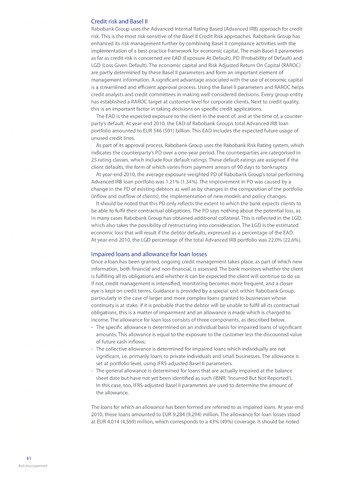Credit risk and Basel II
Rabobank Group uses the Advanced Internal Rating Based (Advanced IRB) approach for credit
risk. This is the most risk-sensitive of the Basel II Credit Risk approaches. Rabobank Group has
enhanced its risk management further by combining Basel II compliance activities with the
implementation of a best-practice framework for economic capital. The main Basel II parameters
as far as credit risk is concerned are EAD (Exposure At Default), PD (Probability of Default) and
LGD (Loss Given Default). The economic capital and Risk Adjusted Return On Capital (RAROC)
are partly determined by these Basel II parameters and form an important element of
management information. A significant advantage associated with the use of economic capital
is a streamlined and efficient approval process. Using the Basel II parameters and RAROC helps
credit analysts and credit committees in making well-considered decisions. Every group entity
has established a RAROC target at customer level for corporate clients. Next to credit quality,
this is an important factor in taking decisions on specific credit applications.
The EAD is the expected exposure to the client in the event of, and at the time of, a counter
party's default. At year-end 2010, the EAD of Rabobank Group's total Advanced IRB loan
portfolio amounted to EUR 546 (501) billion.This EAD includes the expected future usage of
unused credit lines.
As part of its approval process, Rabobank Group uses the Rabobank Risk Rating system, which
indicates the counterparty's PD over a one-year period.The counterparties are categorised in
25 rating classes, which include four default ratings. These default ratings are assigned if the
client defaults, the form of which varies from payment arrears of 90 days to bankruptcy.
At year-end 2010, the average exposure-weighted PD of Rabobank Group's total performing
Advanced IRB loan portfolio was 1.21% (1.34%). The improvement in PD was caused by a
change in the PD of existing debtors as well as by changes in the composition of the portfolio
(inflow and outflow of clients), the implementation of new models and policy changes.
It should be noted that this PD only reflects the extent to which the bank expects clients to
be able to fulfil their contractual obligations. The PD says nothing about the potential loss, as
in many cases Rabobank Group has obtained additional collateral. This is reflected in the LGD,
which also takes the possibility of restructuring into consideration. The LGD is the estimated
economic loss that will result if the debtor defaults, expressed as a percentage of the EAD.
At year-end 2010, the LGD percentage of the total Advanced IRB portfolio was 22.0% (22.6%).
Impaired loans and allowance for loan losses
Once a loan has been granted, ongoing credit management takes place, as part of which new
information, both financial and non-financial, is assessed.The bank monitors whether the client
is fulfilling all its obligations and whether it can be expected the client will continue to do so.
If not, credit management is intensified, monitoring becomes more frequent, and a closer
eye is kept on credit terms. Guidance is provided by a special unit within Rabobank Group,
particularly in the case of larger and more complex loans granted to businesses whose
continuity is at stake. If it is probable that the debtor will be unable to fulfil all its contractual
obligations, this is a matter of impairment and an allowance is made which is charged to
income. The allowance for loan loss consists of three components, as described below.
- The specific allowance is determined on an individual basis for impaired loans of significant
amounts.This allowance is equal to the exposure to the customer less the discounted value
of future cash inflows;
- The collective allowance is determined for impaired loans which individually are not
significant, i.e. primarily loans to private individuals and small businesses.The allowance is
set at portfolio level, using IFRS-adjusted Basel II parameters.
- The general allowance is determined for loans that are actually impaired at the balance
sheet date but have not yet been identified as such (IBNR: 'Incurred But Not Reported').
In this case, too, IFRS-adjusted Basel II parameters are used to determine the amount of
the allowance.
The loans for which an allowance has been formed are referred to as impaired loans. At year-end
2010, these loans amounted to EUR 9,284 (9,294) million. The allowance for loan losses stood
at EUR 4,014 (4,569) million, which corresponds to a 43% (49%) coverage. It should be noted
61
Risk management

